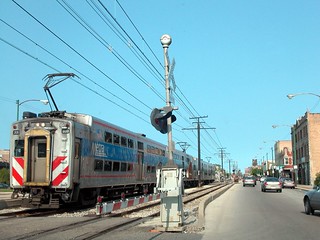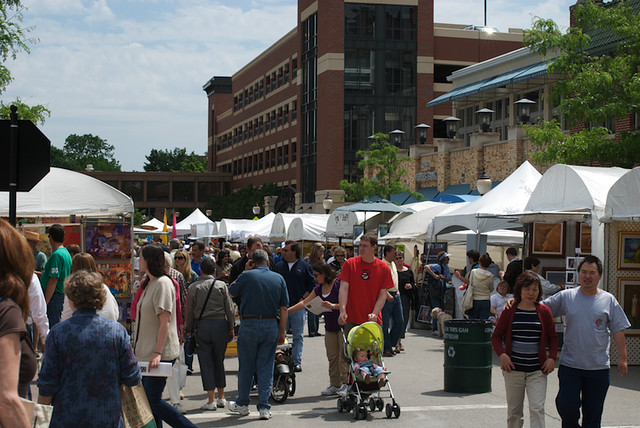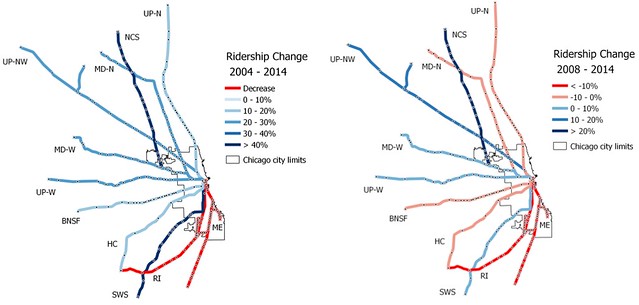Start with the good news: Ridership on Metra, Chicagoland’s main commuter rail service, has grown almost 14 percent over the last ten years. It remains near the all-time high it reached in 2008, just before the Great Recession. On any given weekday, Metra provides nearly 300,000 rides across its 11 lines, or roughly as many as the CTA’s Brown and Blue lines put together. Some lines have even continued to grow, surpassing their 2008 ridership, notably the North Central Service running northwest to Antioch, and the SouthWest Service through Ashburn and Orland Park to Manhattan. Of Metra's more-established lines, the best performer since 2008 has been the Union Pacific Northwest line, which runs through towns like Arlington Heights (pictured above) and Des Plaines that have pursued Transit Oriented Development in their downtowns.
But in other ways, the picture isn’t so rosy. Overall, Metra ridership has stagnated for the last six years, even as CTA rail ridership has grown 16 percent over the same period. More alarming, ridership on several lines -- including the Metra Electric and Rock Island, which have rapid-transit-like stop spacing every half-mile through large parts of the city that lack "L" access -- was falling even before the recession.
Unfortunately, Metra doesn’t provide up-to-date information on ridership by stop, which makes more thorough analysis impossible. (The freshest station-level data available is from 2006.) But the line data is enough to see some patterns. Unsurprisingly, many services lucky enough to go through high-growth neighborhoods and suburbs have the strongest ridership. Conversely, routes that pass mostly through parts of Chicagoland that have lost population are mostly struggling.

That includes Metra Electric and Rock Island, which have the potential to serve as transit backbones through much of the South Side, but currently provide extremely spotty off-peak service. Both lines go through promising territory: Metra Electric’s main line runs from downtown through the South Side’s largest employment hub, Hyde Park, and one branch continues through dense neighborhoods along the south lakefront all the way to 93rd Street. Rock Island stops at the Illinois Institute of Technology, and then makes stops every half-mile at attractive and walkable commercial districts in thriving Beverly and Morgan Park.
The falling ridership on those lines underscores how much of Chicago’s transit infrastructure is being squandered, even as the city waits for federal funds to extend the Red Line to 130th St. A coordinated effort between Metra, Chicago, and the suburbs to increase service and encourage development around walkable stations that serve relatively high population density, could go a long way to improving access to jobs and amenities via transit for hundreds of thousands of people -- and at a fraction of the cost of new rail construction.
At its most ambitious, that might look like the long-sought conversion of the Metra Electric line to true rapid transit -- promoted most recently by the Transit Future campaign. But short of that, Metra could take a page from our sister city to the north, Toronto, whose commuter rail agency recently announced it would increase all-day frequency to every 30 minutes, making off-peak trips there much more convenient.
On the other side of the spectrum, the strong ridership numbers on other lines show that there is an appetite for regional rail transit. Unfortunately, Chicagoland has failed to encourage that growth and reach for its full potential. A report last year from the Center for Neighborhood Technology found that Chicago was the only American metropolitan area with an extensive rail network to see less development inside transit sheds than outside -- even though property values in transit sheds grew much faster than in the region as a whole. Increasing train frequency, and enacting zoning ordinances that allow for transit-oriented development in walkable suburban centers, could turn that trend around.
With more than 240 stations and many hundreds of miles of tracks, Metra is the kind of transportation infrastructure that other American cities can only dream of. But Chicagoland’s civic leaders need to realize the potential of what they already have.






